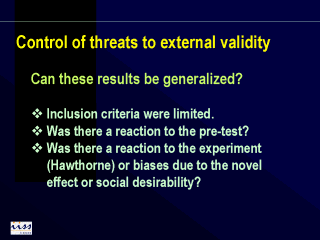| front |1 |2 |3 |4 |5 |6 |7 |8 |9 |10 |11 |12 |13 |14 |15 |16 |17 |18 |19 |review |
 |
Limited inclusion criteria: The drugs selected (NSAIDs) meet three criteria: prescription of these drugs is relevant in terms of prescription volume and costs; the influence of specialists on prescription patterns in “low”; there are practically identical substitutes at different costs in the market. These criteria have undoubtedly affected the effectiveness of the measure. Reaction to the pre-test: Data was not collected from individuals participating in the study, but from an administrative data system. The participants in the experimental group were, therefore, unaware of the pre-test. Reaction to the experiment (Hawthorne), biases due to the the novel effect or social desirability: The healthcare area’s pharmaceutical policy makers regularly program activities to promote the proper use of drugs (doctors receive monthly information on their own prescription profiles, pharmaceutical-therapy sessions are held at the medical centres, all the doctors receive a pharmaceutical-therapy bulletin, etc.) It is unlikely that the experimental or placebo sessions could have been perceived as “experimental” situations. Although there do not appear to be any problems impeding generalization, anyone who wanted to replicate the strategy in order to obtain similar results would have to take into account the following questions: Would other groups of drugs be used? Would other Primary Care physicians be studied? What would be the setting: hospitals, other? Would other materials be used? What type of educational sessions would be organized? Would a “visiting academician” lead the sessions? What would be the administrative climate? Would the pharmaceutical industry respond? |